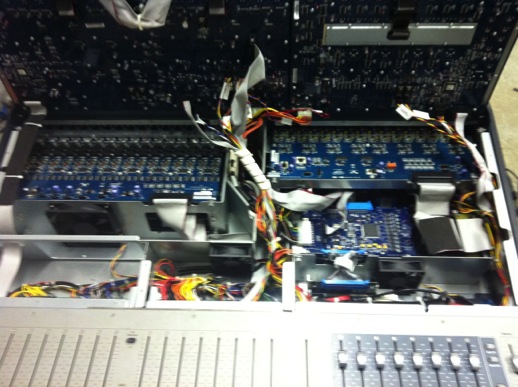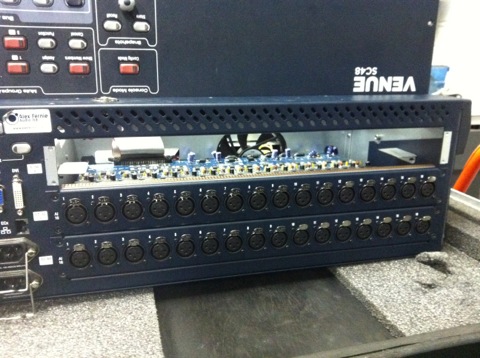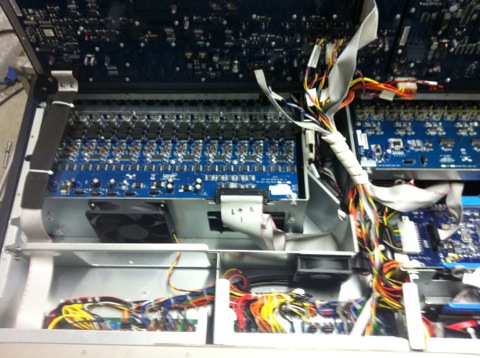LSI May '11: Interview with Jerry Harvey
Clipped this article from this month's Live Sound International, an interview with Jerry Harvey, monitor engineer for Dave Lee Roth and others. IEM innovator and founder of Ultimate Ears. Read....
Upgrading input modules (AI16) on an SC48
Remove 26 hex screws on the top panel and the top of the board lifts up on a hinge, revealing the brains.

After undoing the ribbon cable harnesses, you undo 2 thumb screws at the rear of the unit and the four screws on the front of the unit at the back of the board. Use a sharpie to mark the number and orientation of each ribbon cable. Time 9:10am...

Repeat for the other 2 input modules - a socket set is handy for getting into the hard to reach thumb screws lower down. Time 9:30am....

2 modules already fitted, 9:45am

Last module in, refit ribbon cables, following the marks we'd made with the sharpie earlier...

Top and the 26 hex screws replaced. Ready for testing 9:55am....

Druid Theatre Company Purchase Nexo/Yamaha Touring system
Having being a regular hirer of PS10 and Nexo systems from Alex Fernie Audio Ltd since 2005, it made sense for the company to invest in the new PS10R2. Druid Theatre are currently en route to the US, where "The Cripple of Inishmaan" will tour for the next five months. 2011 promises to be a busy one again for the theatre company, with new productions in the pipeline for the second half of the year.
The combination of the Yamaha LS9-16 with MY16AT card and an Echo Audio AudioFire12 will allow the company to run the sound for shows from a Apple Mac running Qlab Pro via MIDI as they have been doing for the past 2 years. The AudioFire12 is a 12in/12out firewire interface.
The purchase also includes a range of flightcases for amplifiers, consoles, cable and speakers.
Druid have also purchased some EV ZX1's, amplification and microphones for their redeveloped theatre space which, when not in use by Druid, is available to hire for theatre shows, as a rehearsal space or as a venue for press-calls or media receptions.
www.druidtheatre.com
www.nexo-sa.com
www.yamahaproaudio.com
www.echoaudio.com
Technical Riders for Newbie Promoters: Part II
The Technical Rider Continued: Backline, Stage, Risers,
Lighting & Crew
In part I of this series, I discussed elements of a standard sound technical rider. This part deals with the rest of the technical rider.
“Backline” concerns itself with the instruments and amplification of the band. Req uirements for DJs operating in a band environment may also be found here. Most often, bands will carry their own backline. However certain circumstances, such as airline restrictions and schedules, may mean that heavier and bulkier items may need to be supplied by the promoter. Drumkits, keyboards and amplification will be listed in order of preference. Finally, keyboard and guitar stands, drum thrones and other hardware will be listed. Touring bands from the US will often need 220-120v transformers onstage for their own equipment as well as American style 3 pin “edison’ adaptors. European acts may look for “schuko” style 2 pin outlets for the same reason. Reputable backline suppliers will be able to provide anything but the strangest request. Many PA companies will also provide backline as part of their service and will be able to offer PA and backline packages.
Before booking an act for your festival or venue, perhaps the first thing to check is that the band will fit on your stage. A well-written rider will have a minimum stage size specified. Just because a certain 5 piece band fits on your stage, it doesn’t mean that every 5 piece band will. Measuring a stage can be done by anyone and costs nothing but your time. Cramped stages have certain knock on effects. If the singer has to stand right in front of the drumkit, he will need more of his own vocal in his monitors. So the singers monitors are louder, all of a sudden the guitarist can’t hear his guitar amp or his backing vocal in his monitors…well you can guess where this is heading. Ultimately cramped stages end up being louder stages, which ultimately affect the front of house sound which your customers are paying to hear.
Most acts will look for low-level stage sections (risers) for drummers, keyboard or brass sections. Cramped stages often mean that risers can’t be used – so the drummer ends up hidden behind the front line singers and guitarists.
If your stage is too small, enquire about hiring extra stage sections. Again, your local production company will be able to help. If your venue is too small to accommodate the minimum stage size requested by the act, then you better get emailing quickly. DON’T ASSUME THE BAND’S CREW WILL WORK IT OUT ON THE DAY. Generally, if you are upfront with a band on any aspect of a rider, they will come to an agreement or be able to work something out in advance of the show.
As I mentioned in part one, touring theatre shows will have an in depth specification of the lighting fixtures required and will forward on a detailed plan of where they are to be hung in advance of the company’s arrival. Lighting for a theatre show is an integral part of the performance and should be treated as importantly as booking flights and accommodation. Lighting riders for bands are generally less specific and many promoters make the mistake of trying to save money by offering minimal lighting. Effective lighting brings atmosphere and excitement to an act’s performance and will add to the audience’s enjoyment. If you want bands and audiences to return to your venue again, make an effort to contact your local professional lighting company to discuss the bands requirements with them.
Unless you are a qualified professional, DO NOT EVER attempt to hire some lights and hang them yourself over the stage or audience area in order to save money.
Finally, a band may require two or more people as crew to help un-load and load their van. Don’t EVER assume that because you have hired a sound guy and a lighting guy that they will do this. They will have enough to do. If a band requires two people, PAY these two people otherwise they will either not show up for the load out, or they will be drunk at the load out, or they may not show up at all. Nothing makes a roadie cranky like the local crew not showing up sober and on time.
NEXT: More stuff on riders for newbie promoters. How the professionals deal with riders. Why heeding the rider makes business sense for a promoter.![]()
Why a Rider isn't a "wishlist": Part I
It can generally be divided into two sections; a hospitality rider and a technical rider. The hospitality rider deals with accommodation, dressing rooms, food, beverages and security and contain items that are easily organised by most people in a hotel. The technical rider is, to non-production types, often a bewildering array of technical shorthand, model numbers and jargon. If you do not understand a technical rider, don’t sign it until you have consulted with a professional production person.
The quickest way to interpret a technical rider is to pass it on to some reputable sound and lighting companies in your area and ask them to price it – remember, unless you are sure your venue can accommodate the technical rider you will have to pay for any extra equipment. But just so that you have some idea what it’s all about, here’s a quick 101 on artist technical riders.
For music acts, the sound system forms the bulk of the technical rider. Touring theatre companies will concentrate more on the lighting side and will provide a lighting plan which will need to be accommodated by your venue.
The FOH or Front of House system is the sound reinforcement system that the audience will hear. Professional engineers will look for reputable, relatively modern brands and designs that they are familiar with and also that there is enough “rig for the gig”. They will most often give a list of suitable systems and need enough of it to provide consistent sound throughout a venue. Professional sound engineers will never simply state that they need “a 4kW PA” or something similar.
The FOH console is the mixing desk. The engineer/artist will want one that can accommodate all the individual channels from the stage and again, one that is a reputable, modern design. Most professional sound engineers no longer have a problem with using a digital board – some prefer them to analogue mixing desks. Again a list of acceptable digital boards will be listed. If an engineer explicitly states that she does not want a digital board, then suitable analogue boards will be listed. Do not assume that just because an act only needs 16 channels they are just being smart by asking for a 32 channel desk. Analogue boards will require a certain amount of outboard equipment; again suitable makes and models will be listed. Makes and models not wanted will be explicitly listed.
The MONS or Monitor System deals with the speaker system the artist hears onstage and as such is in some ways more important than the FOH system. Do not try to skimp on the monitor system. Similar to the FOH system (see - you’re learning the jargon!), reputable, modern brands and designs will be preferred and listed. Monitor systems for bands will need to provide high sound pressure levels, and often detailed monitor speaker design and processing will be given. For larger venues and acts, an analogue or digital Monitor Console and outboard will be requested in a similar fashion to the FOH console.
Generally these specifications are followed by a stage plan and a channel list. The channel list will detail what microphones and other equipment is needed such as short or tall mic stands. The stage plan will show where everything goes and will help your venue or house sound engineer get everything ready in advance of the band arriving. The stage plan will also detail where power is needed on the stage.
Finally, you may see some makes and models of equipment listed on the rider as UNACCEPTABLE. There is generally a good reason for this. Maybe they break down a lot. Maybe they just sound bad to a trained ear. Maybe they are simply useless products. NEVER ASSUME THAT A PROFESSIONAL ENGINEER OR ARTIST IS SIMPLY BEING AWKWARD, STUCK UP OR IGNORANT. If in any doubt, get a professional opinion.
Just like you, the band and their technical crew want the audience to enjoy the show so that no-one dies, we all get paid and we all go home. So remember a technical rider is just that, it’s not a wishlist but it is a list of necessary and minimum items required to do the job.
NEXT: The Backline and Lighting Rider.
AND AFTER THAT: How professionals deal with riders and advancing a show
Why you should use a professional audio company
Correct Advice
Contrary to popular belief, not all sound companies want to hire you equipment you don’t require for your event. Most sound companies will make an effort to discuss your event with you in advance. They will design a sound system based on the size of the room, its audience capacity and the type of performance or event. For larger events, sound companies use highly specialised software in order to accurately predict the sound pressure levels in all areas of a venue.
The loudspeaker system a professional sound company will recommend for your event will give approximately the same audio experience to all members of the audience, no matter where they are positioned in the room. Modern loudspeakers are highly directional, meaning that they can be positioned to minimise acoustic reflections from walls. Loudspeakers are arrayed in such a way that there is a minimal difference in loudness between the front seats of an audience and the seats at the back.
Having a sufficiently large PA system also means that the risk of feedback during your event is minimal. Feedback, and its distinctive the high-pitched whine, most often occurs where a sound engineer is trying to extract maximum level from an insufficiently powerful PA system.
Professional sound companies will also be able to recommend suitable wired and wireless microphones for different applications. Finally, they will be able to advise you on the smooth running of your event in terms of smooth changeovers between different acts and speakers.
The best thing about professional audio companies is that they will willingly give you all this advice for free.
Modern and Sophisicated Sound Equipment
Professional audio equipment has come a long way in the past ten years. Major developments have taken place in loudspeaker and amplifier design. The continuing evolution of digital equipment and digital mixing offer enhanced sound quality for modern event audio.
All professional audio companies have invested to some degree in this new technology which not only gives a superior audio experience to the listener, but also translates into savings on manpower and transport by being better, lighter and more compact than older audio equipment.
To give one example, a modern 48 channel digital console like the Digidesign Venue SC48 offers the same audio control in a package one-quarter the size of a comparable analogue console and processing package from only 5 years ago. The same is true of modern loudspeaker array systems and amplifiers from companies like Nexo, d&b, EV, l’Acoustics and Meyer.
Modern audio equipment is safer. Professional sound companies spend a lot of time and money ensuring that their equipment doesn’t fail on their events. Equipment is regularly tested for electrical safety and rigging equipment is thoroughly overhauled at least twice a year. If equipment should fail during an event, spares will be to hand allowing the event to continue.
Modern audio equipment and systems are more reliable – professional wireless microphone systems from Sennheiser and Shure rarely fail or drop signal these days. Modern audio equipment is more environmentally friendly – it uses less power and costs less to transport. All this makes modern sound companies more efficient and professional in delivering an excellent cost effective service.
Experienced and Qualified Professional Sound Engineers
Professional sound companies value and look after their staff and freelance engineers equally. Even the best sound system can deliver poor results if poorly deployed and operated. So sound companies spend a great deal of time and money ensuring that all employees and freelance staff are fully up to date on their audio systems, health and safety and manual handling procedures.
A full day’s work for a typical sound engineer can often be up to 12 hours. Professional sound companies ensure that their engineers and crews are well paid for work which involves substantial heavy lifting and long periods of intense concentration in noisy and often uncomfortable surroundings. Professional sound companies will schedule breaks and rotate engineers on longer events. Beware of operations that offer “engineers” at minimum wage levels.
Qualified and experienced sound engineers not only ensure the success of an event but also ensure the safety and well-being of audience members and performers alike. Properly laid and dressed cables on stage and throughout the venue are not just neater looking but they also mean that attention has been paid to their safety. Professional sound engineers are aware of the risks posed by excessive exposure to extreme sound pressure levels and will operate sound systems accordingly.
Professional sound companies will be able to produce a health and safety statement and risk assesment checklist on demand for your event. All staff will be fully aware of procedures in the event of a cause for public concern. Professional sound companies carry full public liability insurance and will gladly produce insurance schedules if asked.
And Finally….
Professional audio is a professional business run by professional people. To do it correctly and to maintain the level of investment needed to be successful, it needs to be a 24/365 service. Whilst many part-time or hobby operations can deliver sound, in order to do it consistently well and to meet the needs of artists, performers and the expectations of modern audiences it has to be run as a professional full-time operation by passionate and professional people.
All of us in the professional audio industry look forward to you call.

